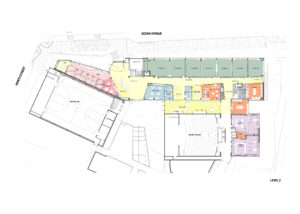In May 2017, Lick-Wilmerding’s Head of School, Eric Temple, announced that the front building of Lick Wilmerding High School would be demolished. That afternoon, the dance students were given permission to draw on the walls of the LWHS studio. However, other students picked up on the idea and gleefully began writing on the walls of the lower hallway, and soon after, the upper hallway. Unfortunately, not all of the writing was good-natured. Hidden amongst the inside jokes and drawings, a few students inscribed the walls with slurs, threats, and insults. One person also projected their political opinion, writing “Trump 2017” along the walls.

One of the first drawings to appear on the dance studio walls. Dragon drawing by Silvana Montagu.
Photo by Robin von Breton
A group of students, including Eloise Schrier ‘18, decided to cover it up. Eloise had left early from school, and missed the initial writing on the wall. When she arrived at home, she “saw that people were putting on their Snapchat stories things that they had put on the walls that they considered to be funny. A lot of those messages were at other people’s expense.” Eloise was surprised and offended by this lack of respect for the community. The following day, she came to school prepared. She brought a batch of paint pens from her graffiti projects, and with the help of some of her friends, drew flowers over the things she found hurtful. One of those things were the Trump phrases. Eloise said that the reason she covered up the pro-Trump phrases was that “A lot of what Trump and his administration stand for goes against who I am and who I identify as, and both erases and victimizes my personal existence.” Eloise wished to feel safe in her own school, and as she said, “everybody has a right to an education that doesn’t feel unsafe.”
I spoke with someone who disagrees. They prefer to stay anonymous, feeling that, “the school doesn’t allow for different political opinions.” They identify as a conservative, but don’t support Trump. They think that the covering of the walls was “an infringement on [their] freedom of speech, and it’s ironic that at a school that’s so accepting, censoring was allowed to happen.” However, they were not at all surprised at the coverings. They had been silenced repeatedly at Lick; on Election Day, they, “were asked to leave the room by a teacher due to the fact that [they] were happy [Hillary Clinton] didn’t win.” They think that writing political views doesn’t count as hate speech, and that Lick is being discriminatory.
Marley Pierce, the former associate for the Center for Civic Engagement, thinks differently. She said that the writing may have been put on the wall just to “rile people up and make people mad.” She reasons that it doesn’t make sense, “Like, how could you vote for Trump in 2017?” She adds that it was wrong to cover the graffiti up because it would only inspire the artist to do it more. Pierce also believes that if the intentions behind the “Vote Trump”s were genuine, then crossing out the inscriptions created a harmful atmosphere of exclusion, where people that are disagreed are silenced, even in a progressive school like Lick.
The day after the writings Eric Temple called an all-school meeting, in which he praised the covering of the hateful messages. However, Temple did not specifically mention the Trump writings. Some people, like the conservative-identifying person I interviewed, thought that they were heavily implied. They thought that it was telling conservative Lick students to, “stay quiet, and accept that they won’t be listened to.” Others, like Pierce, thought that Temple had specifically excluded the writings because of the exclusionary precedent it would set.
Eric Temple had thought that writing on the walls was a fun idea, and that it was a “nice way for the students to say goodbye to the building,” but he was upset to find “that students would [write hurtful] things.” When Temple came in the next day and saw students covering the hateful messages, he was appreciative of them creating a safer environment for their fellow students. Temple’s bigger issue was “the Trump stuff. That didn’t bother [him] as much as it may have bothered some students…[Trump] has come to represent some pretty reprehensible policy.” However, he also thinks that putting “Trump 2017” on the walls could also have been merely a political statement, and did not necessarily intended to target anyone.
Now, the summer has passed. The building is demolished, and the events seem to have vanished with it. A public, candid conversation never occurred and people have forgotten and moved on. Should this be the precedent for issues that make us uncomfortable?






